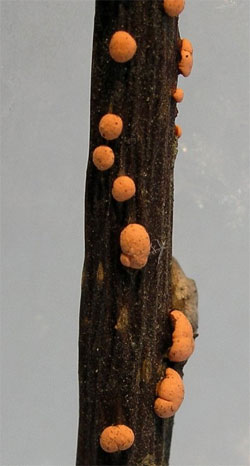Nectria cinnabar red (Nectria cinnabarina)
- Department: Ascomycota (Ascomycetes)
- Subdivision: Pezizomycotina (Pezizomycotins)
- Class: Sordariomycetes (Sordariomycetes)
- Subclass: Hypocreomycetidae (Hypocreomycetes)
- Order: Hypocreales (Hypocreales)
- Family: Nectriaceae (Nectria)
- Genus: Nectria (Nectria)
- Type: Nectria cinnabarina (Nectria cinnabar red)
 Description:
Description:
Stromas are hemispherical or cushion-shaped (“flat lenses”), 0,5-4 mm in diameter, rather fleshy, pink, light red or cinnabar red, later red-brown or brown. On the stroma, conidial sporulation first develops, and then perithecia, located in groups along the edges of the conidial stroma and on the stroma itself. With the formation of perithecia, the stroma acquires a granular appearance and a darker color. Perithecia are spherical, stems tapering downwards into the genus, with a mammillary stomata, finely warty, cinnabar-red, later brownish. Bags are cylindrical-club-shaped.
Doubles:
Due to the bright color, specific shape and size, Nektria cinnabar red mushrooms are quite difficult to confuse with mushrooms from other genera. At the same time, about 30 species of the genus Nectria (Nectria), growing on different substrates, inhabit the territory of the former USSR. Incl. gall-forming nectrium (nectria galligena), hematococcus necrium (n. haematococca), purple necrium (n. violacea) and whitish necrium (n. candicans). The last two parasitize on various myxomycetes, for example, on the widespread putrid fuligo (fuligo septica).
The similarity:
Nectria cinnabar red is similar to the related species Nectria coccinea, which is distinguished by lighter, translucent, smaller perithecia and microscopically (small spores).
Note:









